Serruria dodii
Serruria dodii E. Phillips & Hutch.
Family: Proteaceae
Common names: Hex River spiderhead (Eng.), Hexrivier-spinnekopbossie (Afr.)
Introduction
An upright shrub, often many-branched, that produces silver-pink, sweetly scented flowerheads at the tips of the branches, in spring.
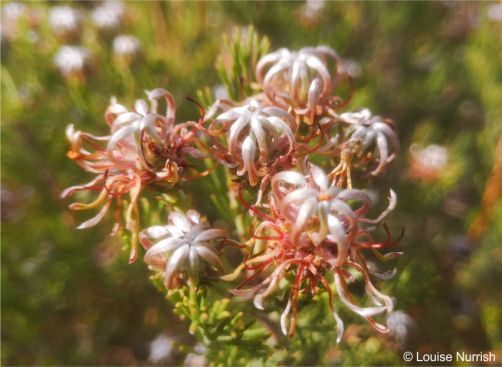
Description
Description
Serruria dodii is an evergreen shrub that reaches up to 1 m tall and spreads to 0.5 m wide, with an upright, main stem of about 15 mm in diameter. Leaves are silvery, silky hairy, upward pointing, about 30-50 mm long and 15-20 mm wide, dissected with 25-30 rounded reddish tips, on a 5-10 mm long stalk.
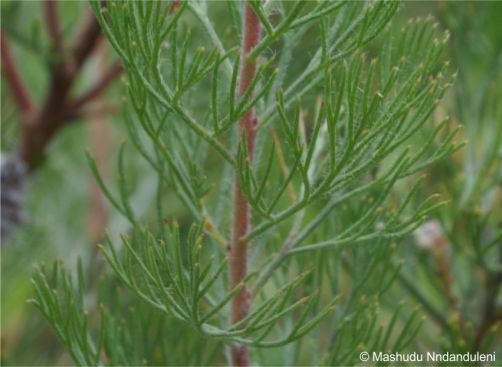
Serruria dodii produces a globose flowerhead, 20-25 mm in diameter, which comprises of a solitary headlet of 12-25 flowers on astalk 6–40 mm long and densely hairy. Involucral bracts are ovate-acute. The perianths are silvery, with adpressed silver silky hairs. The style is about 13 mm long, hairy in the lower third and curving inward, and the pollen presenter is club-shaped and knee-bent at the base. Serruria dodii begins to flower in late winter (August) and flowers though spring to early summer (November) and releases the seeds two months later.
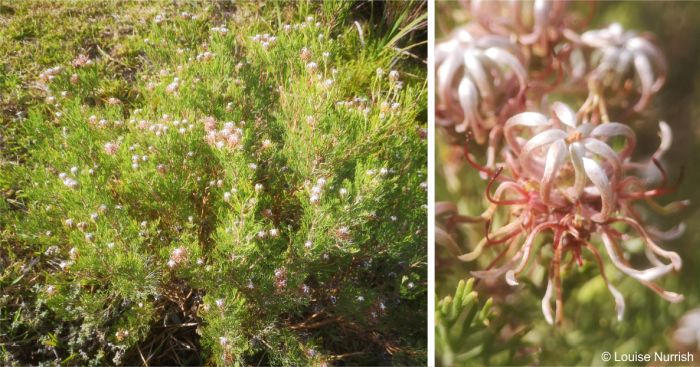
Serruria dodii can be confused with Serruria pedunculata as they look similar.
Conservation Status
Status
Serruria dodii is assessed as Least Concern (LC) on the Red List of South African plants, as checked in November 2024. In the past, approximately 12% of the species was lost due to agricultural activities, primarily vineyard cultivation. However, the remaining population is stable, faces no current threats, and is located within protected areas.
Distribution and habitat
Distribution description
Serruria dodii is naturally found on the Hex River Mountains and Keeromsberg in the Western Cape. They grow in dense stands in isolated populations in fynbos on mountain slopes, in sandstone soil, at about 900-1 400 m altitude.
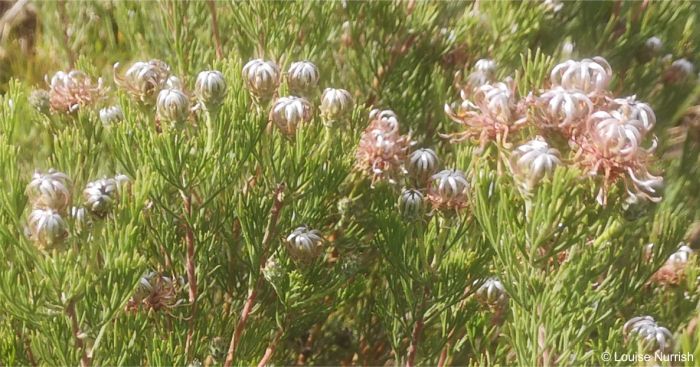
Derivation of name and historical aspects
History
The genus Serruria is named in honour of J. Serrurier, a botany professor at University of Utrecht in the early eighteenth century. This species is named after Anthony Hurt Wolley Dod (1861-1948) who was a retired British soldier with an interest in botany and natural history. While he was Assistant Inspector in the Ordinance Dept in Cape Town from 1896-98, he worked with Harry Bolus on ‘A list of the flowering plants and ferns of the Cape Peninsula’ published in Transactions of the South African Philosophical Society in 1904. He collected about 2 000 plant specimens while in South Africa, including the type specimen that was used to describe Serruria dodii, which he collected in Els Kloof in the Hex River Mountains in 1897.
The genus Serruria has bisexual, regular flowers with four perianth segments that are recurved or spreading and united only at the base or near the base.
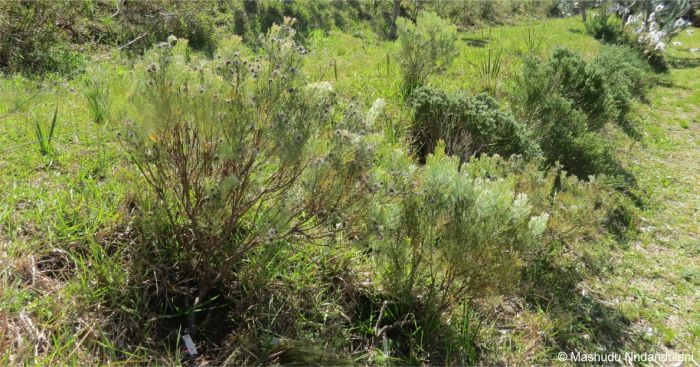
Ecology
Ecology
Serruria dodii flowers are pollinated by insects, which are attracted by the sweet scents that the flowers produce. This species is very dependant on ecological fire for regeneration. It is a reseeder species, which means that the plants are killed by fire and regenerate by seeds stored underground. The mature fruits are shed from older flowers, on the edge of the flowerhead; this process begins while the flowers in the center of the flowerhead are still fresh or have just finished flowering.

The fruits have an elaiosome that ants feed on. Whilst the fruits are attached to the flowerhead, at the bottom of each seed the elaiosome remains hidden. When the fruits drop to the ground, the oily lumps (protuberances) are revealed; they attract ants. The ants carry the seeds to their nests where the elaiosomes are eaten but the fruits are discarded and remain unharmed in the nest, while protected from being eaten by rodents, and from fire. The seeds will germinate after the fire and winter rain.
Uses
Use
Serruria dodii has no recorded cultural uses, but it has the potential to make a charming ornamental garden plant, best suited to fynbos gardens or Mediterranean-climate gardens with acidic soils.

Growing Serruria dodii
Grow
Serruria dodii is one of the species recommended for use in fynbos gardens, especially water-wise gardens. Once the plants establish in the garden, they require very little watering. The species can be propagated by both seeds and cuttings. Seeds germinate well, but seedlings are often prone to fungal infection after being potted up. This susceptibility makes it challenging to grow and maintain the plants in the garden. The flower heads are bagged to collect seeds one month after flowering, allowing for pollination. The seeds will drop into the net bag and should be stored in suitable conditions at an appropriate temperature.
Seeds are sown from late summer to autumn (February to April) in the Western Cape, when temperatures begin to drop and nights are cooler. The seeds are treated with systemic fungicides before sowing to prevent pre- and post-emergence damping-off fungi and are exposed to smoke after sowing to break seed dormancy. The ideal medium is a well-aerated fynbos mix with a pH level between 5 and 7.
Cuttings are taken from summer to autumn. Semi-hardwood cuttings are collected early in the morning while it is still cool. They should be about 30–70 mm long, dipped in a semi-hardwood rooting hormone, and placed in a propagation medium. The trays should be kept in a mist house on warm benches at around 25°C until rooting begins. Seedlings and cuttings can then be transplanted into bags or pots to grow until they are ready for planting in the garden.
To prevent root disturbance, dryness, and weeds, apply a 5 mm layer of mulch in the garden bed. Chipped mulch is highly recommended, as it decomposes slowly and gradually releases small amounts of nutrients to the plants.
References
- Duncan, G., Brown, N. & Nurrish, L. 2013. Grow proteas. Kirstenbosch Gardening Series. South African National Biodiversity Institute, Cape Town.
- Glen, H.F. & Germishuizen, G. (compilers). 2010. Botanical exploration of southern Africa, edition 2. Strelitzia 26. South African National Biodiversity Institute, Pretoria.
- JSTOR Global Plants. Herbarium specimen for Serruria dodii. https://plants.jstor.org/stable/viewer/10.5555/al.ap.specimen.k000423805. Accessed on 19/11/2024.
- Manning, J. & Goldblatt, P. 2012. Plants of the Greater Cape Floristic Region 1: the Core Cape Flora. Strelitzia 29. South African National Biodiversity Institute, Pretoria.
- Rebelo, A.G., Mtshali, H. & Von Staden, L. 2019. Serruria dodii E.Phillips & Hutch. National Assessment: Red List of South African Plants. Accessed on 2024/11/08.
- Rebelo, A.G. 2001. Proteas. A field guide to the proteas of southern Africa. Fernwood Press, Vlaeberg, Cape Town.
- Somtshu, M. & Nndanduleni, M. 2022. Serruria zeyheri Meisn. (Proteaceae). PlantZAfrica. Online. https://pza.sanbi.org/serruria-zeyheri.
- Vogts, M. 1989. South Africa’s Proteaceae. Know them and grow them. Struik Publishers, Cape Town.
Credits
Mashudu Nndanduleni
Kirstenbosch National Botanical Garden
December 2024
Acknowledgements: images by Mashudu Nndanduleni and Louise Nurrish.
Plant Attributes:
Plant Type: Shrub
SA Distribution: Western Cape
Soil type: Sandy
Flowering season: Spring, Early Summer, Winter
PH: Acid
Flower colour: Pink, Cream
Aspect: Full Sun
Gardening skill: Challenging
Special Features:
Horticultural zones








Rate this article
Article well written and informative
Rate this plant
Is this an interesting plant?
Login to add your Comment
Back to topNot registered yet? Click here to register.